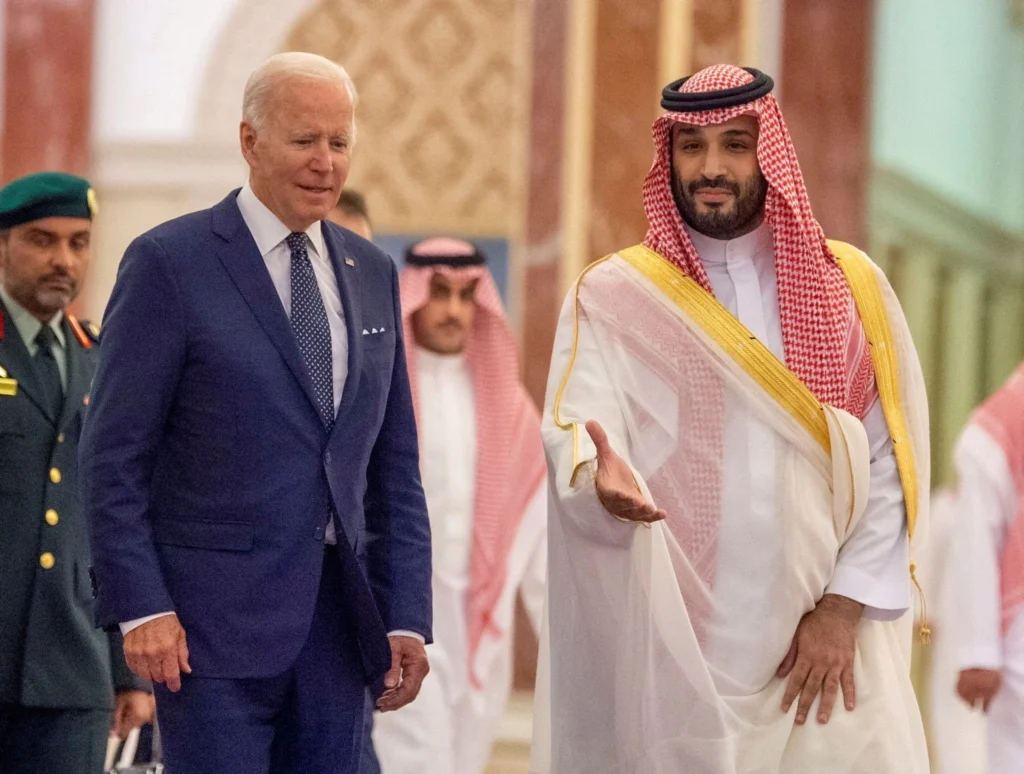U.S. and Saudi Arabia Seal Historic $142 Billion Defense Pact: Strategic Implications and Global Reactions
In a move underscoring the deepening ties between Washington and Riyadh, the United States and Saudi Arabia signed a monumental $142 billion defense agreement during former President Donald Trump’s visit to the kingdom. This deal, part of a broader $600 billion Saudi investment pledge in the U.S., marks one of the largest arms sales in history and reaffirms the decades-old alliance between the two nations. Beyond its economic heft, the agreement carries significant geopolitical weight, reshaping Middle Eastern security dynamics and signaling America’s renewed commitment to countering regional rivals like Iran. This blog unpacks the details of the deal, its strategic implications, and the controversies it has sparked on the global stage.

Background: The U.S.-Saudi Alliance in Flux
The U.S.-Saudi relationship has traditionally been premised on a “oil-for-security” basis, going back to the 1945 meeting of President Franklin D. Roosevelt with King Abdulaziz Ibn Saud. Relations have in recent years, though, strained in Obama administration years over the Iran nuclear pact and Saudi interventions in Yemen. President Trump’s 2017 visit—his first abroad as president—marked a stunning reset, with more emphasis put on arms sales and economic partnership ahead of human rights issues.
The $142 billion defense agreement complements this legacy, which is based on Saudi Arabia’s sense of urgency to update its weapons in the face of increased tensions with Iran and its allies. For the United States, the agreement reinforces home country defense production and solidifies its position as the kingdom’s chief security enforcer.
Breaking Down the $142 Billion Defense Agreement
The deal encompasses a wide array of military equipment, services, and training programs, with key components including:
- Advanced Missile Defense Systems: Sales of THAAD (Terminal High Altitude Area Defense) and Patriot missile systems to counter Iran’s ballistic missile threats.
- Naval and Aerial Superiority: Modern warships, F-15 fighter jets, and Black Hawk helicopters to enhance Saudi Arabia’s maritime and air capabilities.
- Cybersecurity and Surveillance Technology: Tools to combat drone attacks and cyber threats, critical amid Houthi strikes on Saudi oil facilities.
- Maintenance and Training: Long-term contracts with U.S. firms like Lockheed Martin and Raytheon for equipment upkeep and personnel training.
The broader $600 billion Saudi investment package includes infrastructure projects, energy partnerships, and technology transfers, aiming to diversify the kingdom’s economy under Crown Prince Mohammed bin Salman’s Vision 2030.
Strategic Implications: Countering Iran and Reshaping the Middle East
The defense pact serves multiple strategic objectives for both nations:
- Containing Iranian Influence: Saudi Arabia views Iran as an existential threat, particularly after attacks on its oil infrastructure in 2019. The missile defense systems and advanced weaponry will strengthen Riyadh’s deterrence against Iranian proxies like the Houthis in Yemen.
- U.S. Economic Gains: The deal promises to create thousands of American jobs in defense manufacturing, a key talking point for the Trump administration. States like Texas and Florida, home to major defense contractors, stand to benefit significantly.
- Reducing Reliance on Russia and China: By deepening ties with the U.S., Saudi Arabia aims to avoid over-dependence on alternative arms suppliers like Russia (S-400 systems) and China (drone technology).
However, critics argue the agreement risks escalating regional conflicts. Saudi-led airstrikes in Yemen, which have caused widespread civilian casualties, were conducted using U.S.-made weapons. The new deal could further entangle Washington in Yemen’s humanitarian crisis.
Controversies and Criticisms: Human Rights vs. Realpolitik
The deal has drawn sharp backlash from human rights advocates and lawmakers:
- Yemen War Accountability: Congress has repeatedly attempted to block arms sales to Saudi Arabia over its Yemen campaign, which has displaced millions and triggered famine. The Biden administration, for instance, paused some sales in 2021 before resuming them under strategic pressure.
- Khashoggi’s Legacy: The 2018 murder of journalist Jamal Khashoggi, linked to Saudi operatives, cast a shadow over U.S.-Saudi relations. Critics accuse the U.S. of prioritizing profit over principles.
- Regional Arms Race: The deal may prompt Iran to accelerate its nuclear and missile programs, while rivals like Turkey and Qatar could seek similar partnerships with other global powers.
Defenders of the pact argue that isolating Saudi Arabia would push it closer to U.S. adversaries. “Strategic interests sometimes require uncomfortable alliances,” remarked a former Pentagon official.
Global Reactions: Allies and Adversaries Respond
- Iran: Condemned the deal as “aggressive posturing,” vowing to enhance its defensive capabilities.
- Israel: Quietly supportive, as a stronger Saudi military aligns with Israel’s goal of countering Iran. The deal also advances normalization prospects under the Abraham Accords.
- European Allies: France and the UK, major arms suppliers to Saudi Arabia, may face increased competition but could benefit from subcontracting roles.
- China and Russia: Likely to leverage the deal to critique U.S. “militarism” while seeking their own footholds in Gulf security.
The Broader $600 Billion Vision: Economic Synergies
Beyond defense, Saudi investments in U.S. infrastructure, renewable energy, and tech sectors aim to foster long-term interdependence:
- Energy Partnerships: Joint ventures in clean hydrogen and carbon capture align with both nations’ climate goals.
- Tech and AI: Saudi’s Public Investment Fund (PIF) has already poured billions into Silicon Valley firms like Uber and Lucid Motors.
- Job Creation: The White House estimates the $600 billion package could generate over 1 million U.S. jobs over a decade.
The Road Ahead: Challenges and Uncertainties
- Political Sustainability: Future U.S. administrations may revisit the deal amid shifting priorities. Biden’s team, for example, faces pressure to balance human rights with strategic needs.
- Oil Market Volatility: Saudi investments hinge on stable oil revenues, which could fluctuate amid global energy transitions.
- Regional Instability: Escalations in Yemen, Iraq, or Lebanon could test the pact’s effectiveness.
A High-Stakes Partnership in a Multipolar World
The $142 billion defense contract represents the paradoxical intermix of economics, security, and diplomacy in U.S.-Saudi relations. Though it provides short-term benefits for both countries—empowering America’s military-industrial complex and Saudi Arabia’s war effort—it also entrenches patterns of regional conflict and moral compromise. As the world sorts through a new geopolitics, the agreement points to the abiding importance of Middle Eastern partnerships, even as they generate fiery arguments regarding ethics and responsibility. For the moment, the U.S. and Saudi Arabia have doubled down on an alliance created in oil and steel, wagering that shared interests will trump the rising cost of dissonance.
Click here to subscribe to our newsletters and get the latest updates directly to your inbox.

